Nestled in the charming landscapes of Northern Italy you will find the historical and romantic town of Verona. Here you’ll find monumental wonders and beautiful scenes along the river. Imagine wandering through streets that echoes the Roman history and architecture. Verone is a place where every cobblestone and corner tells a story. It’s a place where adventure and romance connect, inviting you to uncover its treasures. Read more about the monumental highlights to visit in Verona and understand the history and architecture.

Table of Contents
Arena di Verona
While many associate the term “amphitheater” with the Roman Colosseum, the Arena di Verona is the evidence of a strong empire’s influence that stretched beyond borders of Rome. The Verona Arena, as it’s often called, wasn’t built overnight. The Arena dates back to the first century, when veterans who had served during times of conquest and gladiatorial games were part of everyday life. Visiting the Arena today means not just stepping into an ancient structure but walking through layers of history that have shaped the Verona we know now.
Architecture
The grandeur of the Roman amphitheatre architecture is on full display at the Arena di Verona. The Arena was originally capable of seating close to 30,000 spectators in its perfect ellipse. The Arena’s limestone exterior was built to survive the centuries.
We go fast forward to the Renaissance. Most like the rest of Europe, Italy experienced a revival of classical learning and wisdom. The Arena didn’t just represent Verona’s link to antiquity. It became a panorama of renewal. Repurposing ancient sites into something beautiful and functional was a hallmark of the Renaissance era. And the Arena’s evolution was no exception.
Time took its toll. During the 19th century an awareness of classical antiquity urged a comprehensive restoration of the Arena. The structure became a cultural treasure in Verona. The Arena today not only serves as a setting for the opera festival that lights up Verona’s summer nights. But also concerts take place of some of the most celebrated voices in popular music.

Cattedral di Santa Maria Matricolare
The Cattedrale di Santa Maria Matricolare is one of the most impressive monumental highlights to visit in Verona. The cathedral is the symbol of the city’s spiritual fame throughout the centuries. The Cattedrale dates back to the time of the Roman Empire. The structure was built on the ruins of its Roman ancestor. The construction of the current cathedral began in the 12th century. This marked the onset of a monumental project that would connect architectural styles and centuries. It is a unique fusion of different elements that remains today.
Throughout its history, the Cattedrale di Santa Maria Matricolare has endured the devastation of wars, endured natural disasters, and persevered through the tides of societal change. One example is the earthquake of 1117 and the following restorations led by Bishop Albert and the master builder Nicolo.
Architecture
Gothic architecture enthusiasts are in for a treat as they walk through the Cattedrale di Santa Maria Matricolare. The interior is decorated with stunning Gothic design elements and this was the start of gothic architecture in Italy. This cathedral underwent a transition where Romanesque foundations gave way to flying arches and complicated stonework.
The interior of the cathedral illustrates the Gothic design philosophy. There are pointed arches, ribbed vaults, and flying buttresses providing a sense of upward motion that is classic to Gothic spiritual expression. Visitors are also attracted to the beautiful rose window. These rose windows are a hallmark of Gothic architecture that lightens up the cathedral’s interior with natural light.
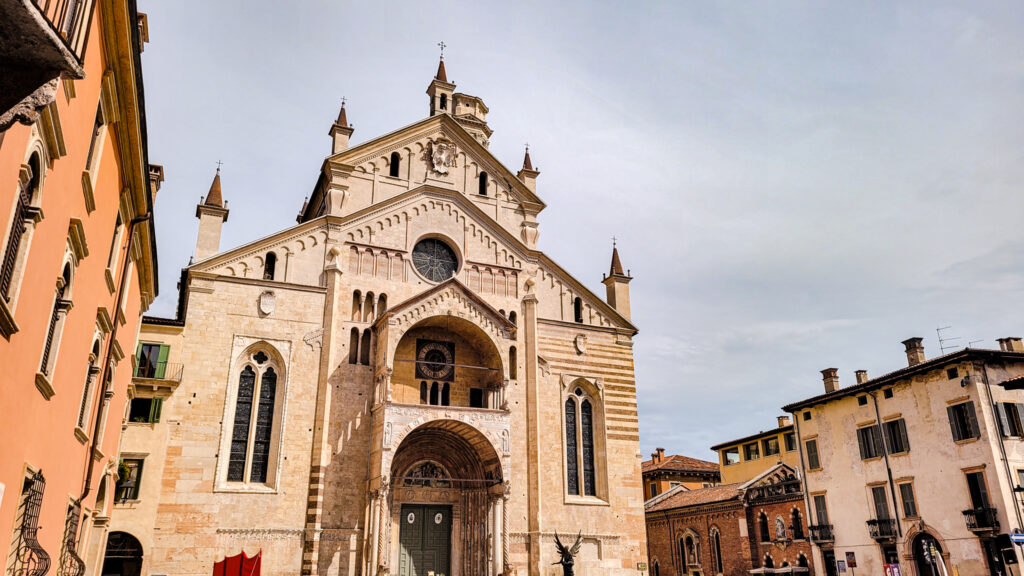
The Real Veronese
The Real Veronese is a particular school of carving. It comes to life through the statues and reliefs that are in the cathedral. Sculptures of saints and biblical figures are carved into the stone. The decorated chapel was consecrated in 1768 by the bishop Bartolomeo Giustiniani. It provides a mosaic of Roman, Byzantine, and gothic influences. The architectural and decorative elements of the Cattedrale are full of symbolism. From the three magnificent portals that represent the Trinity, to the frescoes that narrate the life of Christ and the Last Judgment. Every surface of the cathedral carries a reflective spiritual narrative.
Basilica di Santa Anastasia
The basilica is dedicated to the third-century martyr, St. Anastasia. The basilica stands on a site with a Christian tradition that dates back to Roman times. The first documented evidence of the church are dating back to the fourth century. The structure is a mix of Romanesque and Gothic styles and the result of renovations during the 13th and 14th centuries. It holds the position as one of the largest churches in Verona.
The basilica was a significant religious and ceremonial site. It has witnessed the marriage of prominent historical figures and used to be a place where city decrees were announced. During the Scaligeri rule, the basilica became a mausoleum for the most illustrious members of the family. The decorative tombs are still decorating its aisles, preserving the legacy of Verona’s golden age.
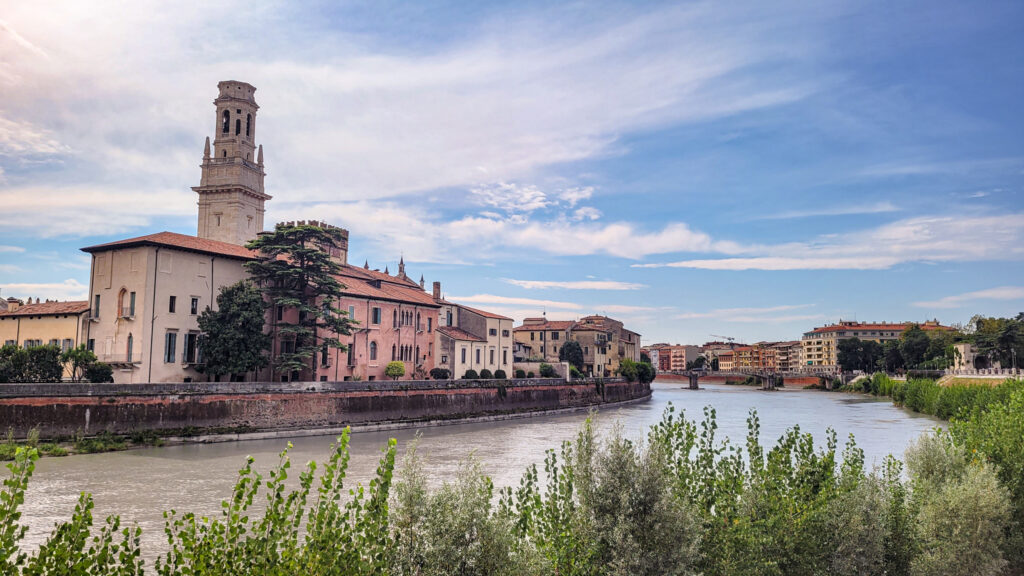
Architectural style and influences
Architecture is a language. The architectural evolution of the basilica can be credited to a combination of design aesthetics. The façade is built in a typical Romanesque fashion. It is decorated with sculpted reliefs that tell stories of saints and biblical scenes. The interior is an excellent example of Gothic influence. The pointed arches and ribbed vaulting are typically that of Gothic architecture. Another unique feature are the exquisite rose windows that produce a kaleidoscope of natural light inside.
Palazzo Maffei
The 15th century was a time of change and rebirth in Verona. This project was initiated by the Maffei family, a powerful and influential clan in the region. The palazzo Maffei was constructed in the late Renaissance and early Baroque styles. This transition is visible in its architecture. The Maffei family became great patrons of the arts, reflecting their status in Verona.
Baroque architecture
Elegance and grandeur are synonymous with the architectural design of Palazzo Maffei. Its grandiose Baroque-style façade is characterized by complex stonework and monumental statues. It was completed by the architect Adriano Cristofali in 1668. The palazzo stands as a model example of Baroque architecture. It is featuring waving lines, robust sculptures, and a remarkable sense of energy that can be observed.
The palazzo’s Baroque elements are timeless. The façade is decorated with mythological sculptural figures like Hercules, Minerva, and even an aging Atlas supporting the world. This last detail brings to mind the family’s strength and support for the progression of Verona.
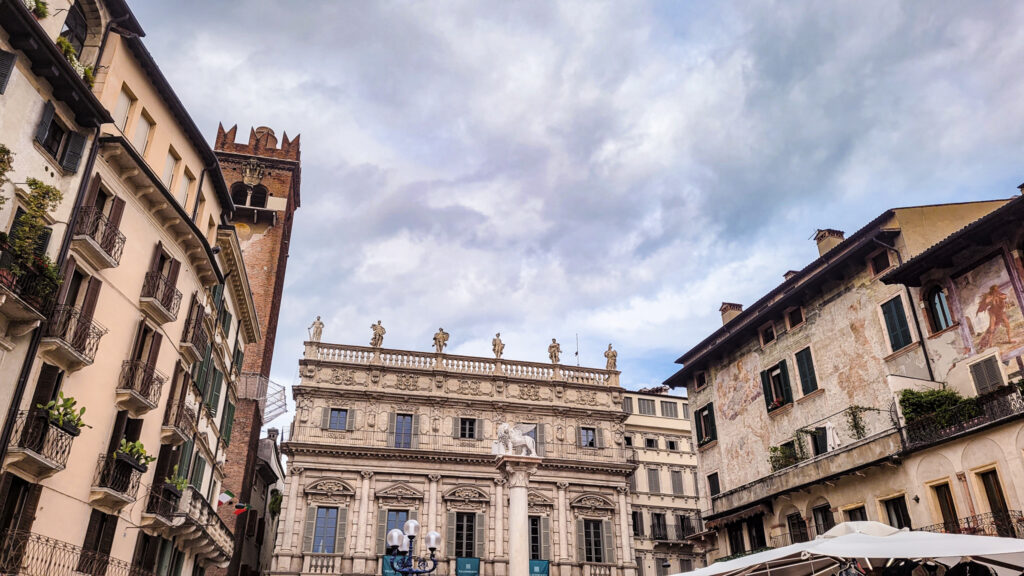
Casa di Giulietta
One of the most popular monumental highlights to visit in Verona is Casa di Giulietta. The building housing Casa di Giulietta is a medieval tower house known as Casatorre. It was first documented in 1351. The tower house once accommodated the inn “del Cappello,” owned by the heirs of Antonio Cappello. The evidence is the coat of arms with a headdress on the keystone of the arch overlooking the courtyard. Due to the headdress emblem, the building was mistakenly associated with the Capulet family during the 18th and 19th centuries. Along with the Montagues from Dante’s Purgatorio. Despite changing ownership multiple times, the building maintained its function as an inn, later adding artisan workshops.
In 1905, the Verona municipality acquired the property, with a partial sale in 1930 to fund the construction of the Teatro Nuovo. The director of public museums, Antonio Avena, established the house museum in 1939. He commissioned the neo-medieval decorations with elements from city collections such as stones, columns, fireplaces, coats of arms, and furniture from the 13th to 15th centuries. The famous balcony of Juliet’s wasn’t built until the 20th century.
Juliet’s house is entirely fictional. But the emotions people have with the tragic love story of Romeo and Juliets is entirely real. These romantic emotions comes from the Hollywood movie Letters of Juliet from 2010. Today the museum is a popular tourist attraction.

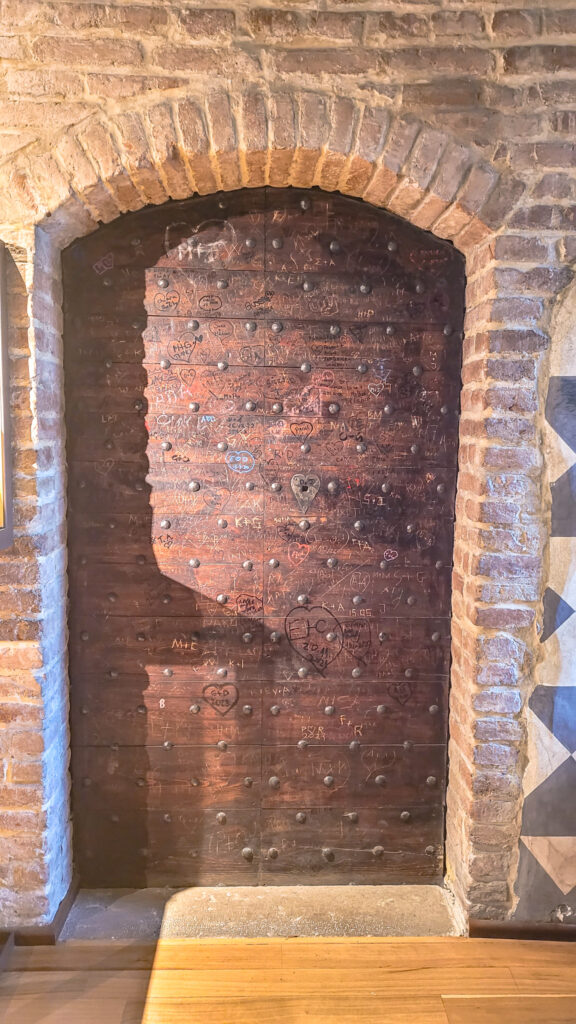

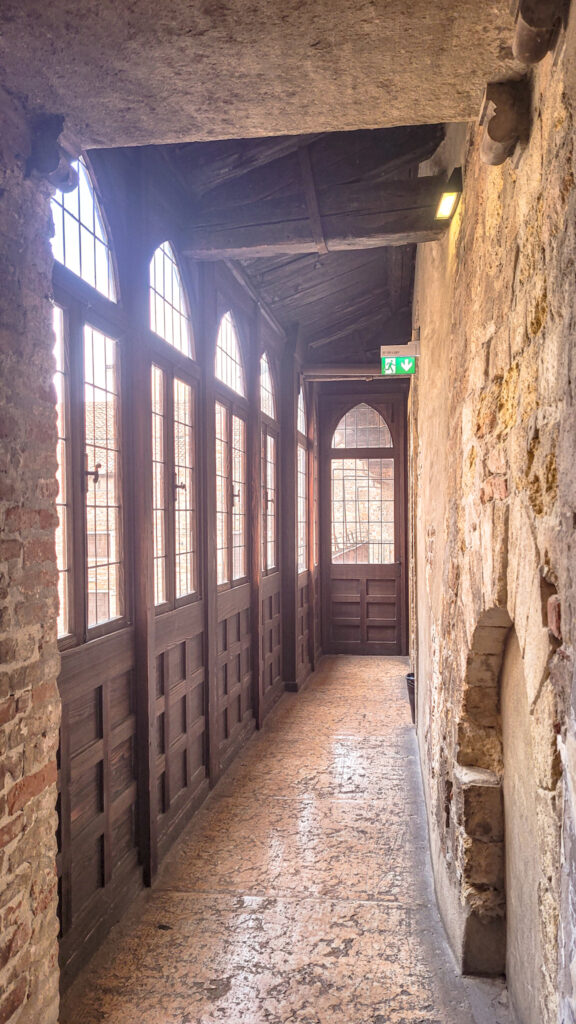
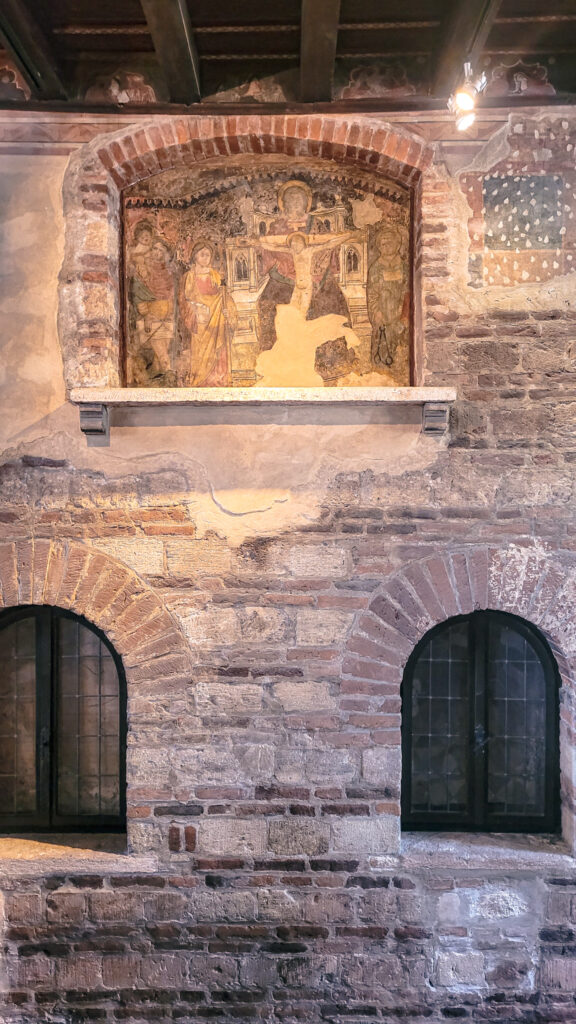
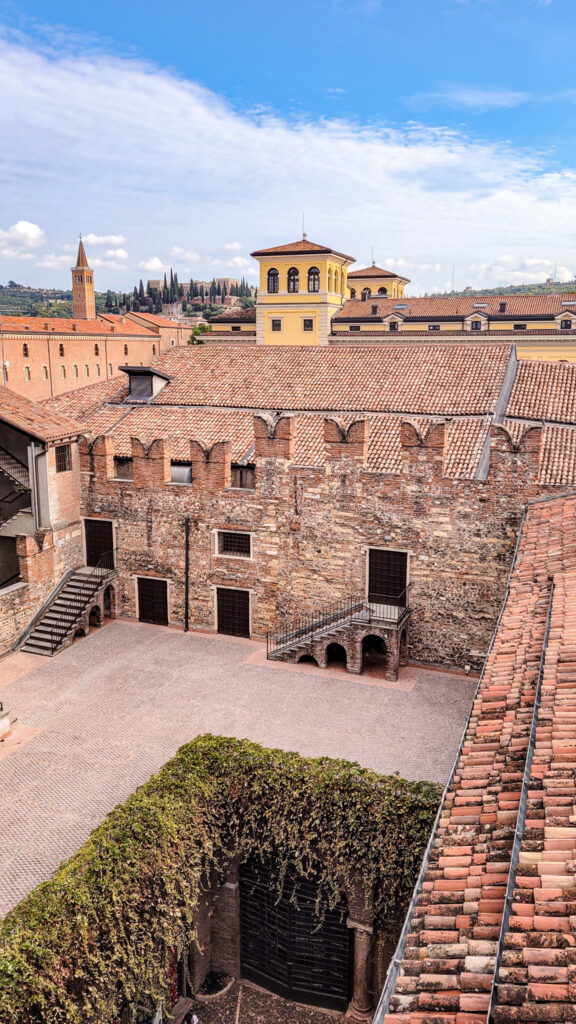
Porta dei Leoni
Porta dei Leoni was built simultaneously with the Roman wall. The construction occurred around the second half of the first century BC. Serving as an entry point to the city, the building had a square layout with a central courtyard where travellers were stopped and inspected. An inscription above the central pillar of Porta dei Leoni is considered to be the founding charter of Roman Verona. It lists the names of the four persons who commissioned the walls and gates of Verona. During the first half of the 1st century, the gate, mostly constructed of brick, was included in the monumental works of the significant Venetian city. This involved adding new stone facades to the sides facing the Forum and countryside, purely for decoration.
The original name of the Roman gate is unknown. But in the Middle Ages, it was first known as Porta San Fermo due to its proximity to the church of the same name. Nowadays, it is known as Porta dei Leoni, derived from the street where it is located. The street was named “via de’ Leoni” as early as the sixteenth century, likely from a Roman tomb monument with lions on top. It is possible it used to be a part of the cemetery extending beyond the gate. The gate has undergone various disfigurements in the late Middle Ages. It was partially incorporated into a residential building. The gate was used as an inspiration and was replicated several times during the Renaissance by renowned artists such as Giovanni Caroto, Sebastiano Serlio, and Andrea Palladio.
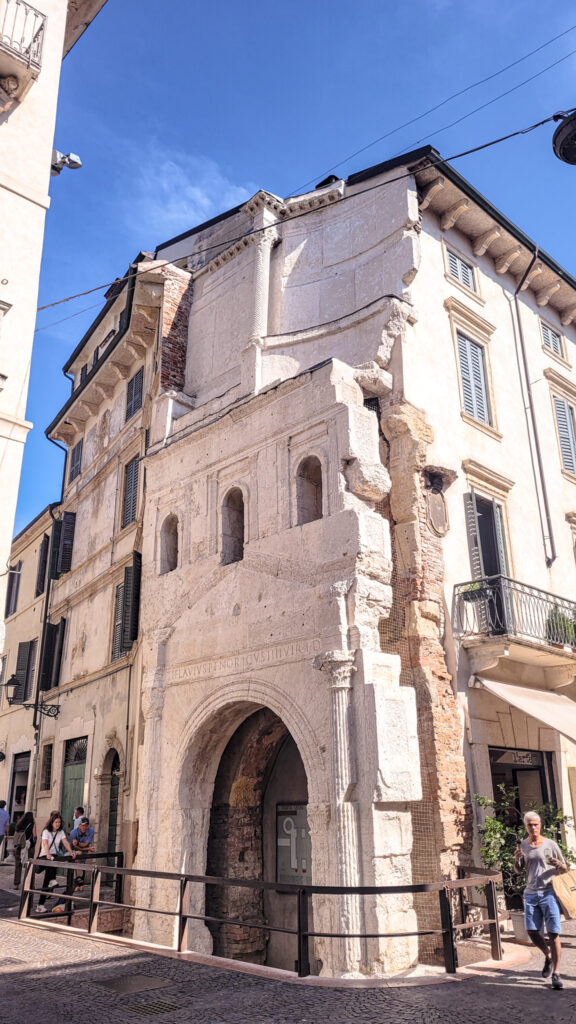
Palazzo della Gran Guardia
The story of Palazzo della Gran Guardia is entangled with the rise and fall of empires. The palazzo was constructed between the 17th and 18th century by the Republic of Venice. The palazzo was designed to serve as barracks, an armoury, and a place for the Guardia Maggiore. The Guardia Maggiore was the military force assigned with maintaining the peace and protecting the interests of the Republic. The initial structure was intended to be a symbol to the formidable strength and strategic importance of Verona within the Venetian territories.
Throughout its history, Palazzo della Gran Guardia has witnessed a mixture of events. From the Napoleonic Wars to the unification of Italy. The palazzo has been at the centre of historical moments. It has also seen numerous changes, transitioning from a military stronghold to a key part of Verona’s cultural and recreational landscape.
Architectural influences
The palazzo’s design reflects the Aristotelian philosophy that influenced the urban planning of many Italian cities. It follows a symmetrical layout. Confirming the humanist principles that were notable during the Renaissance era. The structure blends elements of Baroque and Neo-Classical styles showing the transition in architectural tastes over time.
The most striking feature is the tall, symmetrical façade. The expansive halls are decorated with frescoes and additions that suit spaces once used for displays of military power and ceremonial gatherings. The palazzo now hosts art exhibitions, cultural events, and high-profile conferences. The palazzo is not only a historical landmark but also as an emblem of contemporary Veronese life. Its impact on the city’s real estate and tourism sectors cannot be overstated, attracting numerous visitors who contribute to the economy of Verona.
Giardini Vittorio Emanuele II
The establishment of the Giardini Vittorio Emanuele II dates back to 1869. A committee of technicians were appointed by the municipality to design the area at the eastern entrance of the city, starting from the Maggiore Bridge. The region appeared uncultivated and abandoned, encouraging the committee to propose the creation of a public garden. A draft plan was presented at the municipal library for feedback and suggestions from the residents of Ascoli. The design was well-received by the citizens.
The task was assigned to the painter and librarian Giulio Gabrielli. He uncovered remnants from the Roman era during the construction. Including tunnels believed to have been used for stone extraction. The gardens were inaugurated in 1873. In 1877 there were discussions regarding expanding the green space to include the garden of the parish of San Vittore. But the proposal faced challenges and was not implemented.
In 1879 there was a chalet-style building in the middle of the gardens. This structure was later demolished in 1961 during renovation works to accommodate the statue of King Vittorio Emanuele II of Savoy. In 1998 a local stone from the Ascoli area, were added to the gardens.
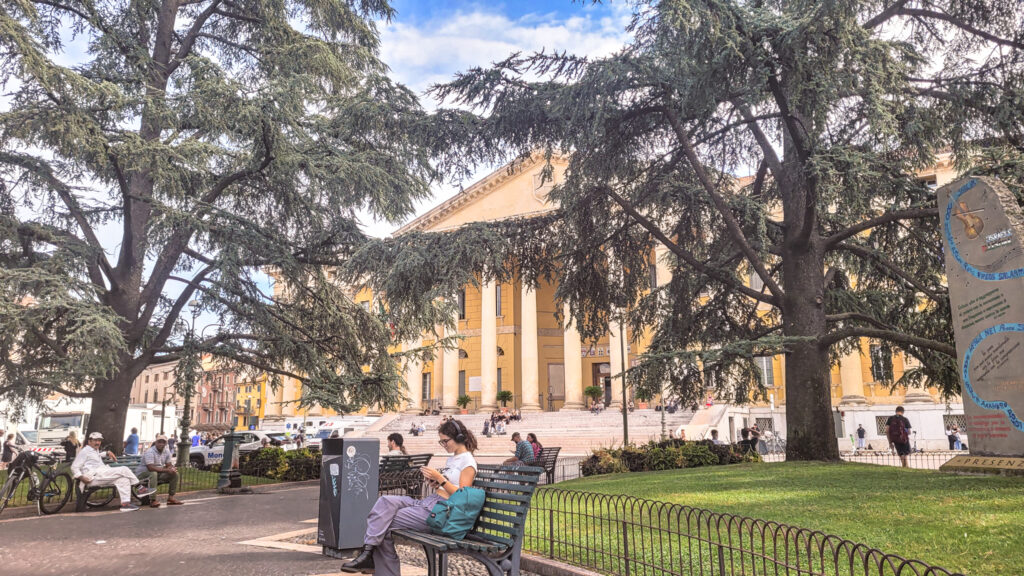
Castel San Pietro
Situated on the San Pietro hill in Verona is a military structure offering a breathtaking panoramic view of the city from its elevated position. The Castel San Pietro is a beloved destination for tourists and locals alike. The castle was carefully crafted by the Austrian Engineering Directorate of the city, built between 1852 and 1858. During this restoration period, the remnants of the original castle’s façade, dating back to the late 14th century, were also preserved. The castle is not open to the public. But it has a panoramic viewing platform and a café were you can go for a drink and enjoy the view of Verona.
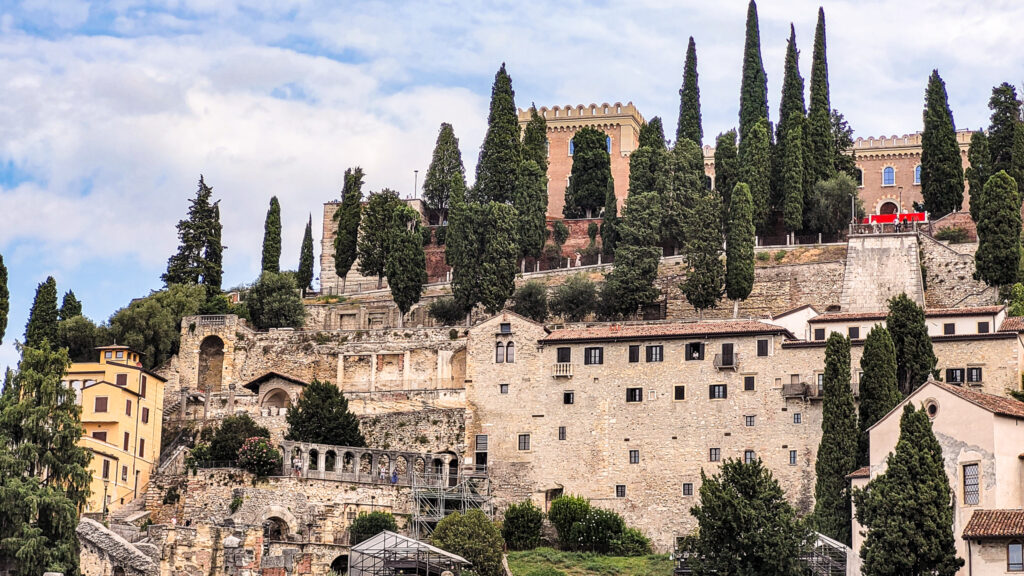
Museo di Castelvecchio
Museo di Castelvecchio was once a military castle commissioned by the powerful Della Scala family in the 14th century. The Castelvecchio fortress was an example of an art and war construction. Over the centuries, the halls of this castle have witnessed conquests, noble lineages, and the passage of time. In the late 19th century, it was the subject of a different kind of conquest: a transformation by the renowned architect Carlo Scarpa. He turned it into the museum it is today.

Architectural treasures
Carlo Scarpa’s architectural vision is both a thoughtful restoration and a harmonious connection. He allows ancient stones to mix with modernity without betraying their origins. The integration of exposed brick, innovative skylights, and flowing water within the Castelvecchio’s fortress walls exemplifies Scarpa’s understanding of space and light. Each corridor leads to a discovery. From the tranquil esplanade overlooking the Adige River to the floors of the old Veronese room. Visitors are not only observers of art but participants in a dialogue of historical continuity that embraces them within the castle’s core.

Art collection
The museum Castelvecchio showcases a diverse and rich collection spanning from the Romanesque to the Renaissance periods. Ancient statues, medieval masterpieces, and canvases by the iconic Paolo Veronese find a collective home. The inner sanctum of the art collections, such as the magnificent “San Giorgio e la Principessa” and “San Sebastiano,” offer an intimate view into a world that once filled with the presence of knights, courtiers, and religious devotees. The collection not only pays attention to the diverse traditions of Northern Italy but also underscores the museum’s role as a custodian of art that transcends time.
Ponte Pietra
The Ponte Pietra is also known as the “Stone Bridge”. It is s a Roman bridge located in the city of Verona, in Northern Italy. Dating back to the 1st century BC, this bridge was constructed when Verona became a colony of the Roman Republic in 89 BC. Spanning the Adige River, the original wooden bridge from the 2nd century BC was replaced by this stone structure to facilitate crucial troop movements towards the north. Built with red Verona marble, the Ponte Pietra was an architectural marvel of its time. The bridge was originally named pons marmoreus or marble bridge.
The Romans erected another stone bridge downstream, known as the Ponte Postumio. This bridge served as a key point on the Via Postuma and an aqueduct for the city. Unfortunately, the Ponte Postumio did not survive over time. Facing partial collapses in 1007, 1153, 1232, and 1239 due to the force of the Adige River, the Ponte Pietra was repeatedly reconstructed. At times they were using wooden materials. Some residents even lived in wooden barracks on the bridge. In 1298, the ruler of the Verona city-state, Alberto della Scala, added a tower to the city centre side of the bridge.
In 1503, the bridge collapsed again. Giovanni Giocondo was a monk-engineer and he was appointed to oversee a thorough restoration in 1508 under the reign of Emperor Maximilian I of Austria. During World War II, the Germans demolished the bridge as they retreated from Verona. The only part they did not destroy was the side connected to the old city centre with the gate. This part remained intact. The bridge underwent restoration between 1957 and 1959, with workers retrieving stones from the Adige Riverbed for the reconstruction.
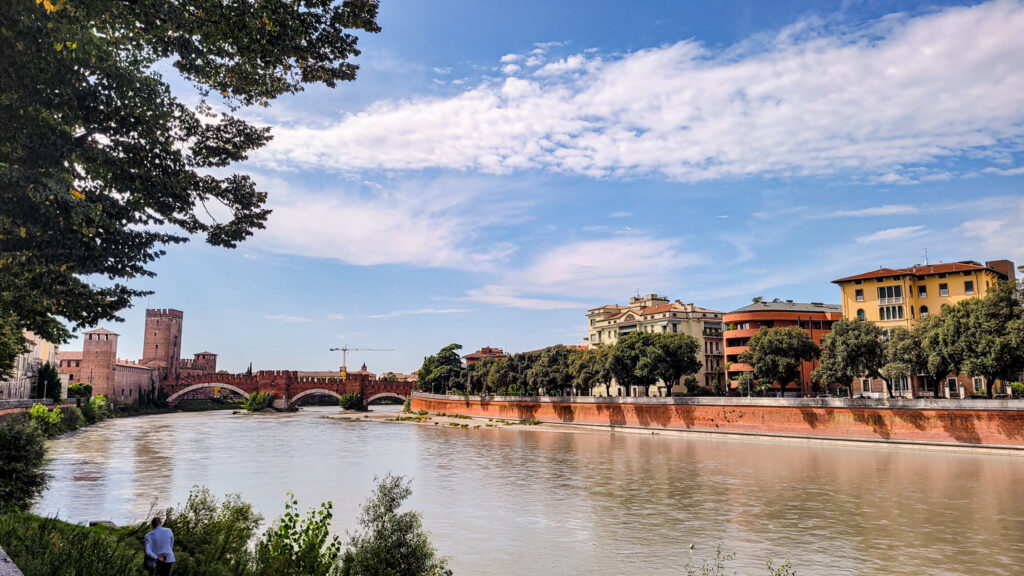
Ponte della Vittoria
The Ponte della Vittoria wass built for several reasons. First one was to commemorate the victory in the Battle of Vittorio Veneto. The second reason was to celebrate the end of World War I on November 4 in 1918. Another important reason was to honour the fallen residents of Verona. The city council decided to construct a bridge dedicated to all three reasons. The municipality of Verona launched a competition in 1924 to select the most compelling design. The competition was won by architect Ettore Fagiuoli and engineer Ferruccio Cipriani. Their proposal, titled “Nec afdalingere nec morari,” proposed a bridge with three arches and two pillars with small panoramic terraces extending from them. This monumental bridge was intended to connect the old town with the evolving Borgo Trento district, linking Corso Cavour to the area formerly known as Campagnola.
Construction began on February 27 in 1926. Prior to the bridge’s construction, several buildings in the old San Michele alla Porta neighborhood, part of the old town, were demolished. During these works, the remains of the Temple of Jupiter Lustral were discovered. These remains were reconstructed initially in the square in front of the church of the Santi Apostoli and later in the gardens outside Porta Vittoria, where they stand to this day.
On the night of April 24, 1945, the bridge was detonated by retreating German soldiers. Along with all other bridges in Verona. Only the right arch remained intact, utilized by the Allies as support for the construction of an iron bridge completed in just one day, crucial for pursuing the enemy further. After World War II the original project was revised by eliminating the panoramic terraces.
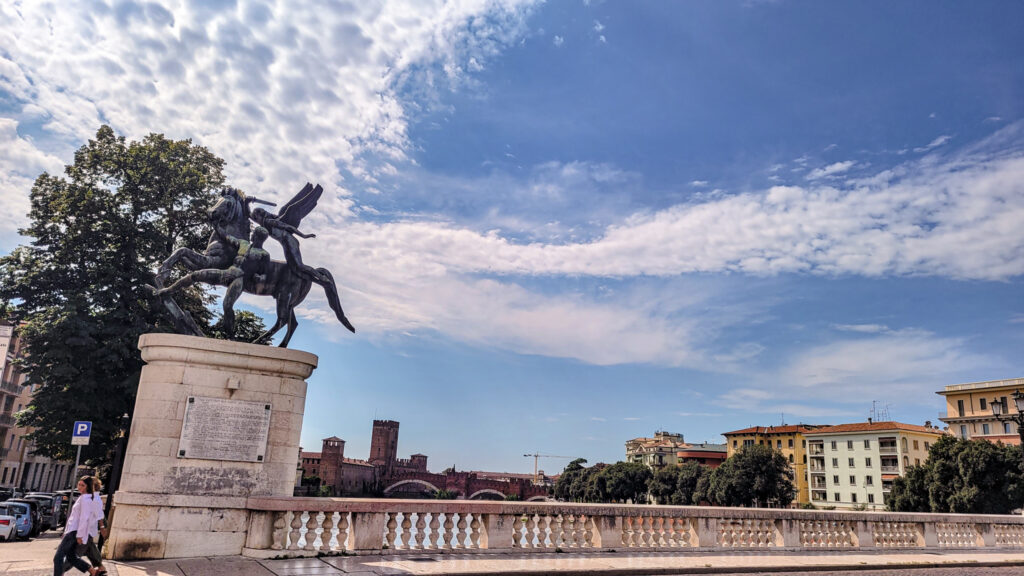
Monumental highlights in Italy
Come and explore the irresistible charm of Italy’s rich historical sites! Take a journey through the monumental highlights of Bologna, one of the most underrated cities in the country. Its history dates back to the Renaissance period, offering an unforgettable cultural and historical experience. And let’s not forget about Modena, a hidden gem where you can escape the crowds and indulge in its unique allure.
When in Rome, you have an incredible opportunity to delve into the captivating history of the Roman Empire. Florence is the capital of Tuscany. Let me tell you, it’s one of the most fascinating destinations in Italy! You’ve got art, architecture, and history all bundled up in this magnificent city. Have you heard about the stunning Duomo and the amazing art collection at the Uffizi Gallery? Trust me, there’s so much to see and explore! In my latest blog post, I’ll be your guide to the most monumental highlights you shouldn’t miss in Florence. Let’s dive in!
And if you fancy a scenic hike with breathtaking views of pristine blue waters, Cinque Terre is the place to be! Discover its history, architecture and culture of this natural wonder in Italy. Or learn more about the monumental highlights to visit in Venice. When you have time don’t forget to visit the Venetians lagoons as well.
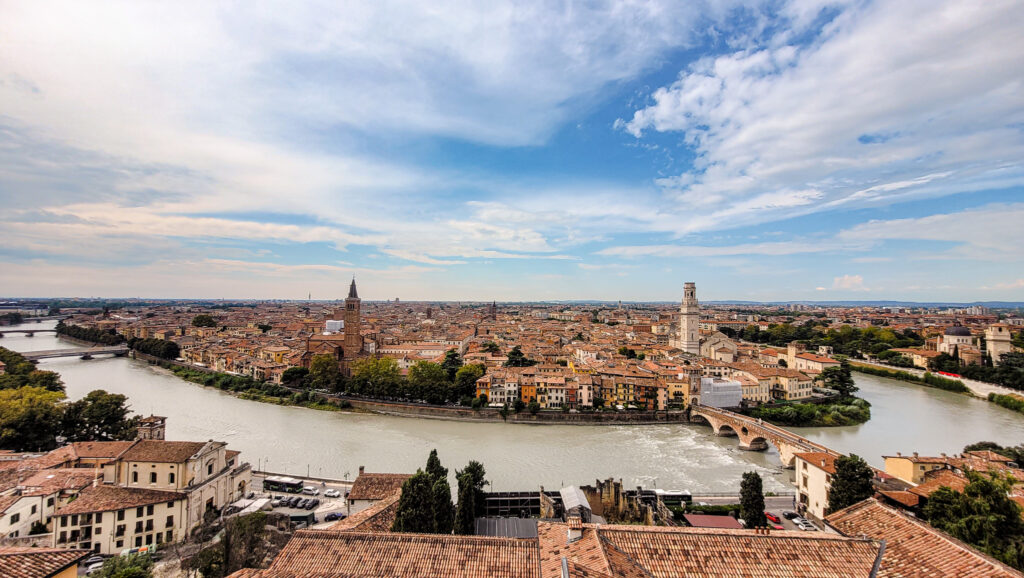
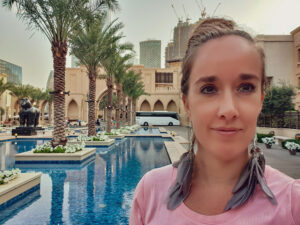
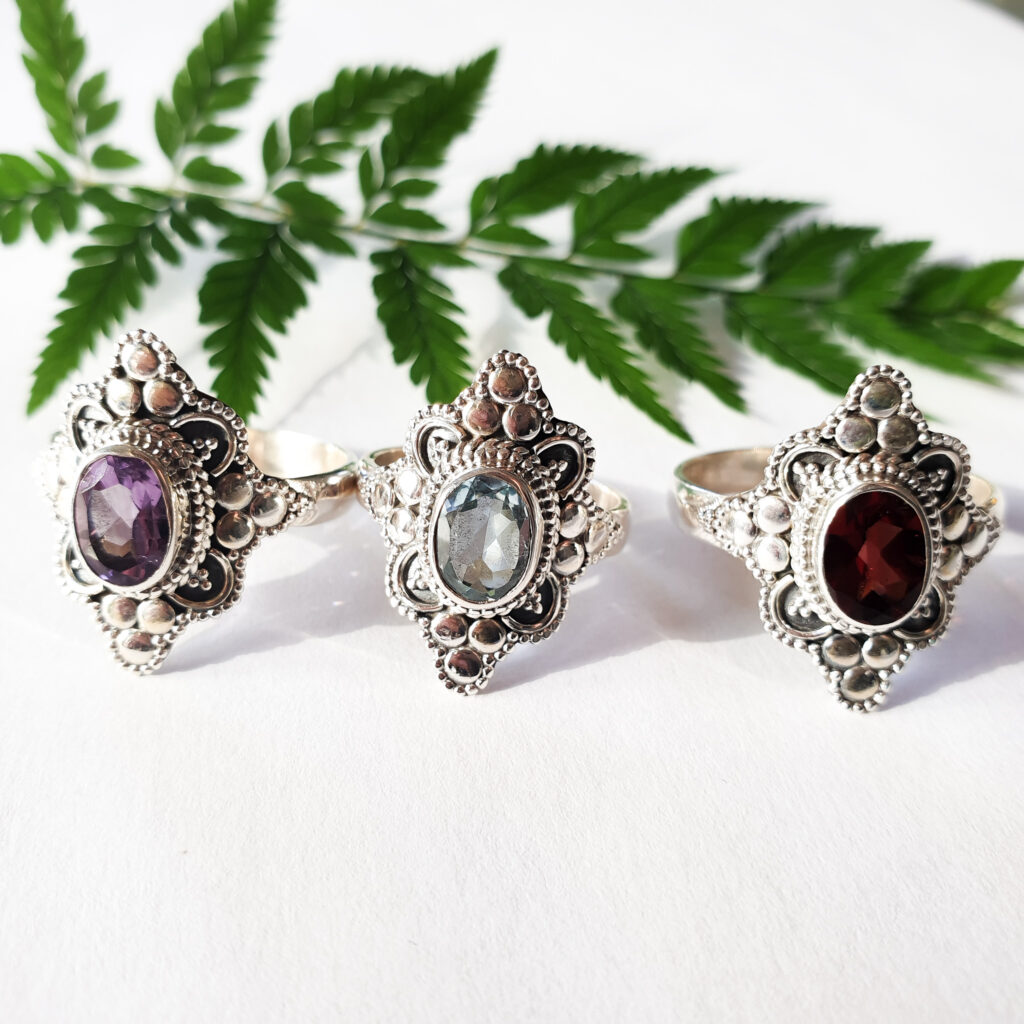
This Post Has One Comment
Knap hoe je interessante artikel blijft schrijven en met prachtige foto’s